HomeReviewsWarhammer 40,000: Rogue Trader
Warhammer 40,000: Rogue Trader review: engrossing, obscure and absolutely exhaustingIn the grim darkness of the far future, there is only More
In the grim darkness of the far future, there is only More
Image credit:Owlcat Games/RockPaperShotgun
Image credit:Owlcat Games/RockPaperShotgun

Image credit:Owlcat Games/RockPaperShotgun

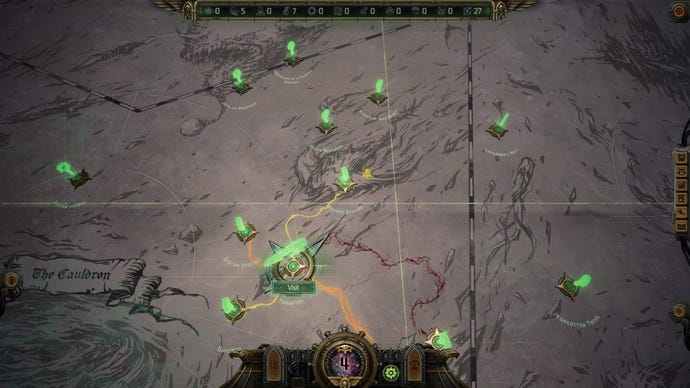
The Koronus Expanse is an intriguing cross-section of Warhammer 40,000’s many silly extremist ideologies. The same is true of your entourage, who make the crew of the good ship Normandy look like a bunch of mild-mannered bureaucrats. Everybody in your gallant band is some kind of weirdo bigot with suppressed violent intentions towards one or more of the rest. Every character has an absurdly convoluted origin story that stretches back centuries, including a few loyalty-quest-defining terrible secrets that soon bubble to the surface. Everybody is a mixture of friend and enemy and ticking timebomb. If you thought Ashley vs Kaiden inMass Effectwas too much stress, just wait till you meet Idira, a Psyker who is doomed to gradually succumb to demonic possession, and Argenta, a zealous Sister of Battle – both are convinced from the outset that the other one is a traitor. Deeper in, there are murdery Dark Elves, slightly less murdery non-Dark Elves and genetically engineered werewolf Space Marines with an unbridled passion for song.
Oscillating between all these viciously opposed worldviews, including an overlapping social dynamic of rich vs poor, is the most enjoyable aspect of Rogue Trader’s story. It’s less enjoyable when you fixate on the main, chapter-based plot, which is incredibly long-winded, and follows a steady rhythm of landing on a planet, talking to a few people to unlock quest areas, then traipsing across a fundamentally linear map to a movie-of-the-week villain.
Image credit:Owlcat Games/RockPaperShotgun
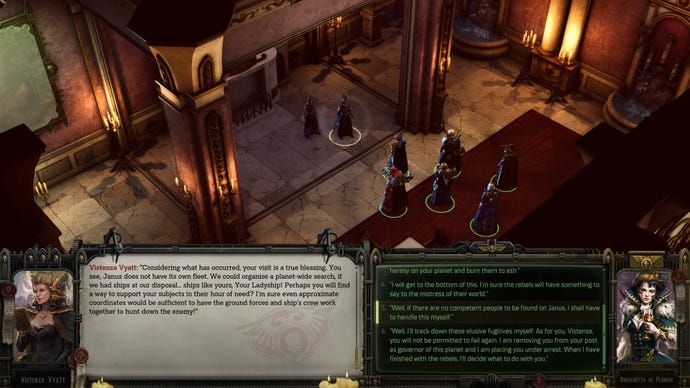
There’s lots to digest, moment to moment. But where obvious rivalBaldur’s Gate 3is an outright sandbox that almost handles like an immersive sim, Rogue Trader is fundamentally a march on the waypoint, for all its opulent wording and framing. While extravagantly built, to the point that you sometimes struggle to see your characters, the tabletop-style maps harbour few exciting secrets beyond caches of loot, traps and incidental lore pop-ups. You’ll want to make a point of gathering the loot regardless, because gifting it to other factions is how you’ll raise your overall Profit Factor as Rogue Trader and gain access to juicier options from merchants.
The range of things that can happen based on any single character action can be absolutely wild. My Eldar ranger Yrliet, for example, has unlocked an ability that causes her next shot to drive the target a few squares out of cover while inflicting reduced damage. This might shunt the target into the gaze of my Navigator, who has a passive that reduces the dodge and hit chance of any enemy she can see, making her a great partner to Yrliet.
Image credit:Owlcat Games/RockPaperShotgun
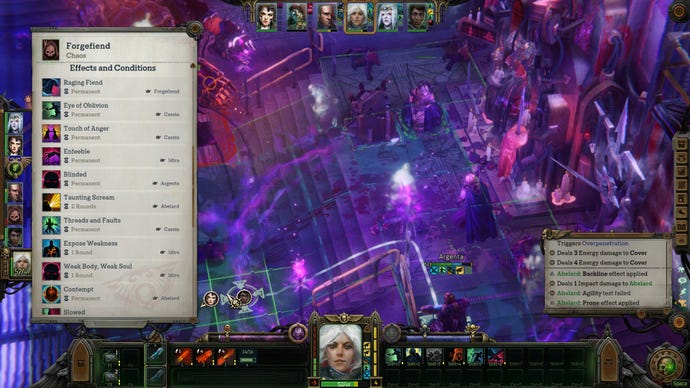
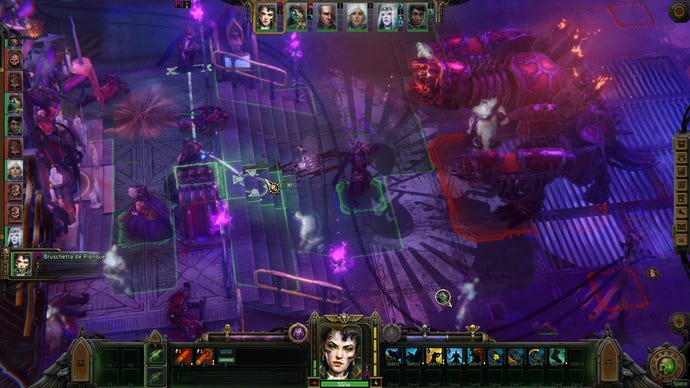
It might also trigger a reaction attack from Idira, who I’ve transformed from a backline support into a kind of magic assassin. If the reaction attack kills the target, and one of my strutting noble characters has decreed that Idira is their Servant for this battle, it might power that noble character up in various ways. But given that Idira is wielding a cursed sword, the reaction attack might also destabilise the veil between mortal and Chaos realms, summoning a demon such as a Bloodletter, just when I thought I had the enemy on the ropes. All this, because my stupid sniper couldn’t be arsed to shoot through cover.
If you love optimising the hell out of a party and chaining their capabilities to moderately break the base systems and stat balancing, Rogue Trader is practically a class-A narcotic. One thing I especially love doing is stacking abilities that confer extra turns, movement points and action points, so as to turn one party member into a sadistic timegod, “stunlocking” the enemy team behind an infinite cascade of moves within moves within moves. Very infrequently, you can have an appropriately overclocked party member clear out a whole room before the slowest of their allies takes a single turn.
I also love the Grand Strategist archetype, who applies different buffs to certain areas and mods terrain – there’s a GS ability that gives characters a free move toward a specific patch of ground, for bonus blitzkrieg. More immediately, I get a real kick out of alternating attack types as the Arch-Militant so as to earn “versatility” and increase their Weapon and Ballistic stats.
Image credit:Owlcat Games/RockPaperShotgun

Each battle and every turn in Rogue Trader is, in short, a frightfully complex energy transaction between characters, enemies, the terrain and the systems - a work of calculation that can be immensely gratifying but also, a real headache to follow. That’s partly inevitable when you have this many variables in play, but the presentation also obscures many of the moving parts – hence, “Find The Buff”.
Status effects are shown on a vertigo-inducing right-click character sheet, with mouse-over pop-ups that don’t quite explain enough. These pop-ups only display the initial, non-upgraded form of each unlockable trait, for example, so if you want to properly assess all the modifications you’ve made before committing to an action, you’ll need to retrace your steps through the archetype screens. The combat log, similarly, can be frustratingly recalcitrant on why, for instance, a character has just earned an extra turn or suffered Warp damage out of nowhere. I feel bad about criticising Rogue Trader’s UI designers, given how much Videogame they have to distil and express, but I would point toDarkest Dungeon 2’s system of status tokens as evidence that readability doesn’t have to be at odds with indecent tactical depth.
Rogue Trader expects you to put the work in to understand these things. It also expects you to be good at visualising scenarios based on arcane maths equations. Each unlock slot on the archetype wheel corresponds to several tabbed lists of generic and specialised abilities or traits, together with weapon or equipment proficiencies and basic stat buffs.
Image credit:Owlcat Games/RockPaperShotgun
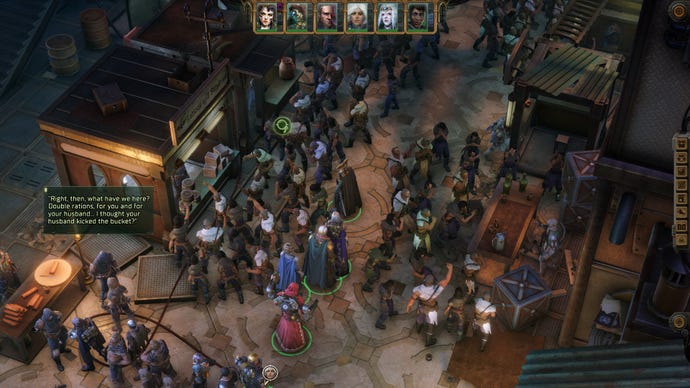
As I noted inmy write-up for embargo, picturing them in action takes a lot of effort. You’ll peer at the descriptive text like a novice monk practising their Latin, and gradually realise that ah, what this basically does is punish an enemy for moving or being moved. It can be a fun challenge, but again, a touch more transparency would have made a big difference: in particular, presenting all the level-up options as tabbed lists makes them feel interchangeable, with too little visual variation between icons. As it is, while I did enjoy wrestling with the intricacies, I’ve never played an RPG in which the sight of a level-up notification made me quit more often than Rogue Trader. I’ve also played few RPGs that are as hard to pick up after an extended absence: you have to spend at least a session remembering what all your characters do.